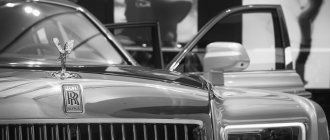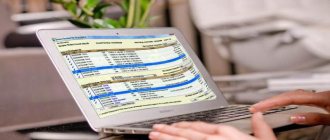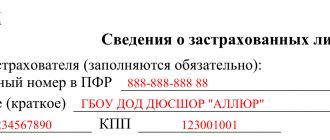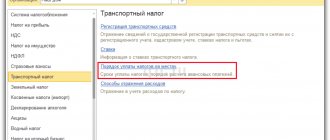Methods of calculation in an organization in accounting
Depreciation in accounting begins the next month - from the 1st day. It does not matter whether the car is registered with the traffic police or not, or whether a change of ownership has been registered.
In accounting, clause 18 of PBU 6/01 provides for 4 methods of depreciation:
- Linear;
- Declining balance – accelerated;
- By the sum of the numbers of years of use;
- Proportional to the volume of products, services, works.
An organization can choose any of the above methods, there are no restrictions.
But it is important to reflect the choice in accounting policies. The depreciation method is chosen to be the same for all similar vehicles.
Answers to pressing questions
Question No. 1. An enterprise purchased a car that was previously in use. According to the new owner, taking into account the condition of the object, its useful life cannot be more than 12 months. How to calculate depreciation correctly in this case?
Answer. If the service life of a fixed asset does not exceed 12 months, you can write off its cost in full immediately without charging depreciation. But the time of actual operation of the car at the enterprise should not be more than a year.
Question No. 2. In what cases does the law allow a legal entity to stop accruing depreciation?
Answer. The law allows you to suspend the calculation of depreciation for a car accident in the following cases:
| For accounting | For tax purposes |
| Transfer to conservation according to the order of the manager for more than 3 months | Transfer to conservation according to the order of the manager for more than 3 months |
| Repair, reconstruction, modernization for more than a year | Repair, reconstruction, modernization for more than a year |
| Free transfer |
Question No. 3. Is registration of a car with the traffic police a prerequisite for the possibility of calculating depreciation? Is it possible to charge depreciation on a car that has been put into operation, but is not registered with the traffic police?
Answer. The basis for starting to charge depreciation on vehicles, as well as on other fixed assets, is its commissioning. At the same time, registration with the traffic police determines only the right of the car to participate in road traffic, but not the moment when depreciation begins to accrue.
Question No. 4. Are there any features when calculating depreciation of vehicles, determined by its type?
Answer. In general, the algorithm and methodology for calculating vehicle wear are the same for different types. But it is worth noting some features:
To calculate wear and tear on passenger cars, it is enough to know the production date, mileage, and the manufacturer’s warranty period against corrosion; For trucks, when calculating depreciation, it is necessary to establish the base cost and useful life period; If depreciation is calculated on buses and tractors, then it is important to accurately determine the model and service life; When calculating the wear and tear of special construction equipment, the initial cost is taken into account without the cost of tires. For tires, depreciation is determined separately. Question No. 5
How is the depreciation of a car written off when it is disposed of?
Question No. 5. How is the depreciation of a car written off when it is disposed of?
Answer. The disposal of vehicles is reflected in accounting as follows:
- Dt02 Kt01 – accrued depreciation is written off;
- Dt91 Kt01 – for the amount of the residual value.
Methods for tax accounting
It is important to know depreciation in order to correctly calculate income taxes. Depreciation deductions reduce the tax base by writing off as expenses.
The Tax Code of the Russian Federation quite strictly defines the procedure for writing off the cost of fixed assets through deductions.
To determine the useful life, a Classification has been developed, according to which depreciation group 3, 4 or 5 can be selected for a car. How to choose a shock absorption group for a car?
In tax accounting, in accordance with clause 1 of Article 259 of the Tax Code of the Russian Federation, only two methods of calculating depreciation are possible:
- linear;
- nonlinear.
An organization can choose any one, reflecting it in its tax accounting policy.
It is important that the prescribed calculation method will apply to absolutely all fixed assets.
It will be possible to change it only from the beginning of next year, again for all OS objects at once. You can change the nonlinear method to a linear one no more often than every 5 years.
An exception is the property listed in clause 3 of Article 259 of the Tax Code of the Russian Federation; for it it is mandatory to use the linear write-off method, regardless of the general method chosen (buildings, structures, transfer devices).
Nuances
The purchased car must be registered with the traffic police. But this process may take several weeks due, for example, to the lack of forms. Depreciation must be calculated from the next month after commissioning. But what if by this time the car has not yet been registered? There are no clear instructions in this regard in the Tax Code of the Russian Federation. But financiers argue that even an unregistered vehicle can be depreciated, since traffic police officers simply register the car and do not register ownership.
The period of use of the vehicle in the NU is determined according to the approved OS Classification. It can also be used for used cars. It is enough to subtract the number of years of operation, which are documented, from the period indicated in the reference book. If the vehicle was purchased from an individual, then this data is contained in the vehicle passport. If the previous owner was a company, then it is worth raising the OS acceptance certificate.
Sometimes a situation arises when the actual time of use of the vehicle is equal to or exceeds the maximum period provided for by the Classification. In such cases, the owner can determine the period independently, “in accordance with safety requirements” (Article 259 of the Tax Code).
If an organization purchases an expensive vehicle or minibus, then it must depreciate it using a reduction factor (standard x 0.5). In fact, depreciation will accrue twice as long, which will affect the amount of deductions. This procedure is the responsibility of a company that bought a passenger car at a price exceeding 600 thousand rubles, or a minibus worth more than 800 thousand rubles. Until 2008, other maximum amounts were in effect: 300 and 400 thousand rubles. respectively. However, you will still have to use a coefficient of 0.5 for vehicles whose initial cost is less than the established values, since the selected depreciation method cannot be changed during the period of operation of the vehicle.
conclusions
A car is recognized as a fixed asset if it is not intended for resale. Its useful life is determined and depreciation is charged.
In accounting, it is convenient to choose either a linear calculation method or proportional to the volume of work - by kilometer (based on mileage).
In tax accounting, you can choose a linear or nonlinear method.
For vehicles leasing, you can use an accelerated method of deductions using an accelerating coefficient.
The operation of your own or leased transport requires tax and accounting to approve the parameters for calculating physical depreciation - period, monthly amount. Regardless of the depreciation method, the useful life of the vehicle is the determining criterion for the calculation.
Accounting legislation suggests that enterprises independently determine the time of productive operation. The Tax Code limits specialized classifiers, offering preferences. Example: the useful life of a leased car for tax purposes can be reduced by 2 times. To eliminate the occurrence of differences and to simplify accounting, paragraphs of tax legislation are used in practice.
Calculation by reducing balance
This is accelerated depreciation. In the first years, the amount of write-off of the initial price is accrued at a faster rate than in subsequent years. The very first figure is annual deductions. It corresponds to the total cost of the car at the beginning of the accounting year. The monthly amount corresponds to 1/12 of its part. The acceleration factor is applied to the formula. Example.
Auto Services LLC purchased a GAZ-Cruise bus for intercity transportation for 2,550,000 rubles, and paid 5,000 rubles for vehicle registration. The service life of the bus is limited to 8 years. The company decided to calculate the depreciation of the new bus using the reducing balance. Contribution rate: 2: 8 x 100% = 25% annually. Calculation:
| Year | Calculation | Annual depreciation |
| 1 | 2,555,000 x 25% | 638 750 |
| 2 | (2,555,000 – 638,750) x 25% | 479 062, 5 |
| 3 | (2,555,000 – 638,750 – 479,062.5) x 25% | 359 296 |
| 4 | (2,555,000 – ….– 359,296) x 25% | 269 472 |
| 5 | (2,555,000 –….– 269,472) x 25% | 201 933 |
| 6 | (2,555,000 –…. – 201,933) x 25% | 151 621 |
| 7 | (2,555,000 –….– 151,621) x 25% | 113 716 |
| 8 | (2 555 000 –….– 113 716) | 85 287 |
| Total | 2 299 137,5 |
By calculating this way, the initial cost will not be completely written off (2,555,000 – 2,299,137.5 = 255,862.5). The Ministry of Finance allows this amount to be included in the expenses of the last month of using the bus.
How to determine the useful life of a passenger car
Article 258 of the Tax Code establishes 10 depreciation categories of property, systematized by periods of minimum and maximum efficiency. The classifier of fixed assets reveals which group the transport accepted on the organization’s balance sheet belongs to. It groups fixed assets according to assigned numbers in accordance with the OKOF standard (All-Russian Classifier of Fixed Assets).
To find the useful life of a car, we first select the groups into which it may belong. Then the parameters are specified through OKOF.
Example
The company bought a VAZ 2172 (Priora). In the Classifier we find that passenger cars are included in categories 3, 4, 5, in which the useful life of the car varies from 36 to 120 months. But the fourth has specialized models for disabled people, and the fifth has an engine capacity of 3.5 liters and a higher class. Domestic cars are intended for the middle class of the population and the total capacity of the Priora cylinders, according to the technical passport, is 1.6 liters.
In the third group, the useful life of a passenger car according to the classifier is 3-5 years and the general code OKOF 310.29.10.2 is indicated. Decoding the meaning will show that only new cars with an engine capacity from small to large, using diesel and gasoline, fall under this category. There is no division into manufacturers in legal acts. The technical specifications and release date are important.
How to determine the depreciation period of a used or undocumented passenger car? Tax Code in paragraph 12. Art. 258 classifies used property in the same group as new property. There are 3 options available for selecting a working suitability standard:
- Apply the depreciation periods for vehicles specified in the Classifier for new objects;
- Exclude the time of operation by the previous owner from the period accepted in the Classifier, and apply the remaining time for calculation;
- Use the car's depreciation period accepted by the previous owner minus the period before purchase.
Important. The certificate of technical equipment does not confirm the depreciation period of the car, its operation - the decision of the Moscow District Court in case No. A40-191195/14 dated 10.14.2015.
Establish the useful life of the truck
For trucks, the time for effective operation and reasonable maintenance is determined similarly to cars. There are depreciation groups and OKOF codes. From the transcripts it is clear that:
- Transport with a carrying capacity of no more than 3.5 tons belongs to group 3;
- The useful life of a truck crane, as well as dump trucks, flatbeds, and vans is over 60 to 84 months inclusive;
- The fifth group included trucks with a carrying capacity of 3.5 tons, garbage trucks, trailers, and tractors.
In the Classifiers, the depreciation period of a truck does not depend on the engine size or fuel used. The weight transported, lifted and technical equipment are of decisive importance.
Specialized means of transportation are scattered across different groups. Example: stackers are used on a par with garbage trucks, and a concrete truck and a forklift have a useful life equal to a truck crane. Therefore, when putting property on the balance sheet, one must take into account the characteristics specified by the manufacturer. And using them to accurately determine the category of the vehicle - this will help avoid disputes with regulatory authorities.
Knowing how to determine the useful life of a car is necessary in accounting not only for the correct calculation of depreciation, but also for property insurance. Both expenses reduce taxable income, and inspectors scrutinize properties.
In the process of work, the organization can install new equipment on the vehicle to replace what has become unusable or in order to improve operational parameters. The depreciation of the car and its useful life depend on the type of innovation. Example: a van was placed on a flatbed truck - the load capacity decreased due to an increase in the total weight.
What is this
Depreciation of vehicles refers to the accounting of their general physical wear and tear, as well as the wear of individual components.
It is important to understand that each car has a limited operational life, which will gradually decrease due to the use of the car for its intended purpose.
When wear and tear increases, vehicle maintenance costs also increase. At the same time, the income that the machine can generate if used for commercial purposes is reduced.
Each car has a so-called useful life or useful life period. It directly depends on the depreciation group. In total, there are 10 groups, but vehicles can belong to 3 of them.
Group No3 includes the following vehicles:
- passenger cars;
- small buses;
- small buses with a length of no more than 7.5 m;
- machines with a load capacity of up to 0.5 tons.
Vehicles may also belong to depreciation group No4, which includes:
- buses with a length of no more than 12 m;
- vans;
- trucks;
- tractor trailers;
- disabled cars.
Group No5 is also used. It takes into account:
- passenger cars with an engine capacity of more than 3.5 liters;
- trucks, including trucks with a carrying capacity of over 5 tons;
- tractors;
- road trains;
- special vehicles (firefighters, ambulances, etc.).
That is, depreciation can be called a write-off of the initial cost of a vehicle, which occurs depending on the degree of wear and tear. This allows for gradual and piecemeal write-offs over the entire operational life.
There is a special coefficient for proper depreciation of a car, as well as different calculation methods. Among them there is also accelerated depreciation. It was she who significantly increased the demand for passenger cars issued through leasing agreements. That is, when leasing, taking into account the depreciation period of a passenger car, they prefer to use the accelerated method. But more on that a little later.
Depreciation is required for everyone who runs a business. Moreover, the calculation is made not only in relation to the machines purchased by the company. This is also mandatory when hiring an employee with his own car, which is planned to be used for business purposes.
Depreciation costs are recorded in accounting and tax records. Moreover, the company is obliged to regularly record expenses. Such calculations allow:
- report to the tax authorities on the company’s expenses;
- estimate the real value of the vehicle for the insurance company>;
- operate your own vehicles for the company’s needs;
- lease cars.
For accounting and tax employees, it is extremely important to know when depreciation begins, how the useful life is determined and which method to use in the calculations.
Car depreciation
Current on: July 18, 2021
If an organization purchased a car for long-term use in the production of products, when performing work or providing services and does not plan its subsequent resale, it must be depreciated in accounting (clause 4, 17 PBU 6/01). And if its initial cost in tax accounting also exceeds 100,000 rubles, the object will also be depreciated for the purpose of calculating the tax base for income tax (clause 1 of Article 256 of the Tax Code of the Russian Federation). We will tell you about the procedure for car depreciation in accounting and tax accounting in our consultation.
When do we start depreciating the car?
In accounting, depreciation of a machine begins to be calculated from the 1st day of the month following the month it was accepted for accounting (clause 21 of PBU 6/01). Let us recall that fixed assets are accepted for accounting using the following entry (Order of the Ministry of Finance dated October 31, 2000 No. 94n):
Debit of account 01 “Fixed assets” – Credit of account 08 “Investments in non-current assets”
In tax accounting, depreciation expenses for a car begin to be recognized from the 1st day of the month following the month in which the object was put into operation (clause 4 of Article 259 of the Tax Code of the Russian Federation).
Please note that the fact that the car is registered with the traffic police does not matter for calculating depreciation (Letter of the Ministry of Finance dated June 13, 2012 No. 03-03-06/1/303).
Determining the useful life
The useful life of a car is the period of time during which the car is expected to bring economic benefits to the organization (clause 4 of PBU 6/01). Based on the SPI, the amount of monthly depreciation charges is determined.
In tax accounting, SPI is established by the Classification of fixed assets included in depreciation groups (Government Decree No. 1 of January 1, 2002, clause 1 of Article 258 of the Tax Code of the Russian Federation).
We explained in our consultation what depreciation groups cars belong to.
For example, passenger cars with an engine displacement of no more than 3.5 liters belong to depreciation group III. Consequently, when calculating the depreciation of a passenger car, the useful life can be chosen by the organization in the range from 37 months to 60 months inclusive.
In accounting, the SPI is established by the organization independently, taking into account the expected period of use of the car, physical wear and tear and other factors (clause 20 of PBU 6/01). In this case, the accounting SPI can be established similar to the deadline in tax accounting.
Choosing a depreciation method
An organization can independently choose the method of calculating depreciation on a car, both in accounting and tax accounting.
The following methods are allowed in accounting (clause 8 of PBU 6/01):
- linear method;
- reducing balance method;
- method of writing off value by the sum of the numbers of years of useful life;
- method of writing off cost in proportion to the volume of products (works).
And in tax accounting there are only 2 methods (clause 1 of Article 259 of the Tax Code of the Russian Federation):
- linear;
- nonlinear.
At the same time, in accounting, the depreciation method must be the same for all vehicles included in a group of homogeneous objects, and in tax accounting - in general for all depreciable assets (except for those for which depreciation, regardless of the chosen method in relation to other assets, is always accrued only linear method) (clause 18 of PBU 6/01, clauses 1,3 of Article 259 of the Tax Code of the Russian Federation).
When estimating the value of a car, the question arises, how to calculate the depreciation of a car? The formula for calculating depreciation of a car and the online calculator help to more accurately calculate the depreciation of a car.
Over time, every car becomes cheaper, the price decrease occurs due to physical and moral wear and tear. Physical wear and tear is a measure of the obsolescence of parts, components, and bodywork. It is affected by the intensity of use, environmental pollution, and climate.
If you use the car for its intended purpose, productive wear and tear occurs. If the car is parked in a garage, then physical wear and tear still occurs, but it is called unproductive.
Obsolescence occurs due to obsolescence of technology and the release of new car models with improved qualities. The monetary expression of physical and moral wear and tear is called depreciation.
In accounting, depreciation calculation is needed to write off the cost of the car and maintenance costs in parts. If you write off a lump sum at the end of using the machine, you will see a loss on your balance sheet.
In order to evenly account for the profit from the operation of the machine and the loss from wear and tear and operating costs, depreciation is calculated at intervals of once a month or a year. This reduces the tax base.
Calculating car depreciation is also useful for the vehicle owner. For example, if the work involves driving, and the company compensates for part of the costs and wear and tear.
The calculation will be needed to sell and buy a car, to understand the actions of appraisers in car pawnshops, insurance companies, and banks. This will allow you to understand how the process works and estimate the order of payment amounts.
Important aspects
How to get a car loan without a down payment in 2019
The presence of motor vehicles on the balance sheet of an enterprise adds trouble to the accountant. It is necessary to take into account all operating costs in a timely manner, as well as calculate depreciation.
The first question accountants have is when depreciation begins. The purchased car must be registered with the traffic police. Should a car be depreciated from the date of purchase or from the date of registration?
When should you start depreciating your car? There are no legal provisions linking depreciation and registration date.
As a result, many companies believe that depreciation of a car can only be done after registration with the traffic police. But in reality, everything is not quite like that. Registration with the traffic police is the registration of a car.
Whereas registration of rights means the right to own property. By purchasing a car, the organization becomes its owner. To be put into operation, the vehicle must be in a usable condition.
Thus, the beginning of depreciation of the car does not depend on registration with the traffic police. Although this is necessary for admission to participation in road traffic.
Basic Concepts
Depreciation of a car involves gradually writing off its value due to physical wear and tear. Simply put, an organization buys a car, but writes off its value not at once, but gradually over several years.
Depreciation charges are included in production costs. They are deducted from the cost of the property. Depreciation is the cash equivalent of wear and tear.
The need to charge depreciation on a car arises when:
| The organization acquires | Car ownership |
| The company is hiring an employee with a car | Which one is used for production purposes? |
Thus, the costs of maintaining vehicles do not become irreparable losses for the enterprise. Calculating depreciation for a car is not as complicated as it might seem.
It is enough to timely take into account the costs of car maintenance throughout the year. The resulting total amount is divided by the mileage. As a result, the cost of one kilometer of travel is determined.
Knowing how many kilometers a vehicle has traveled over a certain period of time, you can calculate the total amount of depreciation. This approach requires the driver to record all expenses. Sometimes cost accounting is handled by the accounting department.
The latter depends on the age of the car and its natural wear and tear. The book value is divided by the number of months of the useful life and thus the average depreciation rate per month is determined.
Methods for calculating depreciation may be different. Among the main ones it should be noted:
- linear;
- reducing balance method;
- write-off of funds in proportion to the volume of work performed;
- accelerated method.
Various factors are taken into account in the depreciation calculation process. For example, wear rates or acceleration coefficient.
These parameters are constantly changing. You can find indicators or formulas for calculating them in various accounting literature or special periodicals.
Why is it needed?
A fairly common situation is when an employee uses a personal car to perform official duties. In this case, the employer is required not only to pay for fuel, but also for wear and tear of the machine.
To do this, the depreciation of one kilometer is calculated. Based on the calculated indicators, the employer pays for the use of the car.
Well, the most important reason for calculating depreciation is the write-off of the cost of fixed assets owned by the enterprise. When buying a car, an organization spends a certain amount.
To prevent this, the initial cost is gradually reduced, and the difference is written off as production costs.
Normative base
Clause 49 of the Methodological Instructions talks about the need for depreciation to pay off the cost of fixed assets that the organization owns by right of ownership, economic management, and operational management.
This is defined for any depreciation group. The assignment of fixed assets to depreciation groups is determined by Article 258 of the Tax Code of the Russian Federation. The exact useful life of the transport is established by a special inventory commission.
In accounting, the entity has the right to independently establish the useful period, which is stipulated in clause 20 of PBU 6/01. But as usual, the periods in tax and accounting accounting coincide.
Separately, we need to touch on the cost of the car. Until 2009, in relation to expensive cars, a car depreciation coefficient was applied - an accelerated depreciation coefficient equal to 0.5. Currently this provision is not applied.
How to calculate car depreciation
There are several methods in accounting; the choice depends on the class of the car, the purpose of its use, and the terms of the contract. The simplest and most frequently used is linear. It uses the following formulas:
- Depreciation charges = Cost without VAT* Depreciation rate/100 (A=C*Na/100)
- Depreciation rate=1/useful life*100 (Na=1/ppp). The useful life period depends on the class of the car; it is indicated in the regulatory tables. For a passenger car with an engine capacity of less than 3.5 liters, this period is 3-5 years.
- Depreciation rate = Depreciation charges/Cost of the car without VAT (Ki=A/C)
For example, let's take a car with an initial cost of 600,000 rubles. The useful life period is 5 years.
This formula is used not only for accounting calculations. Suppose you are a taxi driver, you bought the car from the example above and want to calculate how much you need to earn per month so that the car, without taking into account the costs of its maintenance, will pay off in five years.
Take the resulting depreciation value and divide it by the number of working months. Let there be 11 of them, and 1 is a vacation. 120,000/11=10,909 rubles per month.
When making calculations for MTPL, in banks, car pawnshops, and trade-in companies, a different formula is used:
Physical wear and tear of the car = (I1xPf+I2xDf)xA2xA3xA4
- I1 – mileage wear (% per 1000 km);
- Pf – actual mileage in thousand km, rounded to 0.1;
- I2 – aging depending on the intensity of use;
- Df – actual service life in years, rounded to 0.1;
- A2 – wear due to natural and climatic conditions;
- A3 – wear from environmental conditions;
- A4 – depreciation by the number of inhabitants in the region.
The current coefficients are indicated in. If you don’t want to count manually, use special online services; they will accurately and quickly calculate using this formula.
They use data about your car, the climate in which you live, the intensity of use of the car, and the number of residents in the region.
Car depreciation calculation
Let's assume we buy a passenger car produced in 2012, with an engine capacity of 1.4 liters, dimensions from 3.6 to 3.9 m, mileage of 75,364 km in Barnaul. New cars of this brand cost 600,000 rubles, the seller set a price of 450,000 rubles.
Is it a lot or a little? Let's look at the table of zoning according to the climatic conditions of the regions of the Russian Federation - the Altai Territory belongs to a cold climate.
Environmental aggressiveness is high (85 kg of atmospheric emissions per inhabitant). The number of residents in the region is 700 thousand.
Let's calculate the average annual mileage. 75,364/5=15072.8 km/year. This value corresponds to coefficient I2=0.89
I1=0.4, Pf=75.4, I2=0.89, Df=5, A2=1.12, A3=1.07, A4=1.050
Let's calculate the value ourselves:
(I1xPf+I2xDf)xA2xA3xA4=(0.4x75.4+0.89x5)x1.12x1.07x1.050=43.55%
We got the value of normal wear and tear. Let's calculate it in money:
600,000x43.6/100=261,600
The cost of the car for 2021 will be 600,000-261,600=338,400.
Let's calculate the cost taking into account obsolescence in the online service. It turned out that the market value of the car being valued is 338,400x(1 - 0.2) = 270,720 rubles.
Now you know how to calculate the depreciation of a car and can use the data obtained when bargaining.
Calculation of depreciation per 1 km of run
In addition to the loss in value due to wear and tear, the car requires maintenance costs. To calculate depreciation per 1 km, we need the following data:
- Operating fuel consumption per 100 km and the price of 1 liter of fuel.
- Mileage readings for the year.
- Insurance cost per year.
- Maintenance cost per year.
- Depreciation (loss of value) per year.
- The amount of road tax for the year.
The price of fuel per 1 km is calculated using the formula: consumption/100*price of 1 liter. Divide the prices from points 3,4,5,6 by the number of kilometers from point 2. Add the resulting values, you get the cost of 1 km of your car.
Online services for calculating depreciation
A service that uses the formula from our example for calculating depreciation -. If it doesn't work, you can follow the link.
To calculate the depreciation of a car per 1 km, use the calculator, a more detailed version
Accounting calculations are made in special programs, for example, 1C. But you can also use online services -
In case of an accident, calculations of wear of parts, components, and body are used. You can calculate it manually, but the formulas use logarithms, so it’s easier to use a special calculator: , .
Methods for calculating car depreciation
To calculate transport wear and tear, four methods are used in accounting. These four techniques are divided into linear and nonlinear. The company personally chooses the more suitable method for itself and uses it to calculate depreciation write-offs.
Car depreciation
Accruals for automobile depreciation can be calculated using the following options:
- linear option;
- reducing balance option;
- option of deducting the price based on the sum of the numbers of years of useful consumption;
- option to write off the price according to the size of products or services.
Linear depreciation method
The linear method of calculating transport depreciation is that the finances that are accrued for depreciation within one month are calculated by multiplying the initial or replacement price of depreciation specific for a given property.
To calculate the depreciation rate using the linear method, you need to know the number of months of useful transport consumption. Then you need to divide the unit by the period of useful use (calculated in months) and multiply by one hundred percent. The resulting figure is annual; to calculate monthly deductions, this value must be divided by 12.
This method of calculation is the most common due to its simplicity. Accrual of transport depreciation must begin on the 1st date of the month, which is subsequent to the month the vehicle was put into use. And these wear and tear are written off in equal amounts throughout the entire period of consumption.
Linear method example
Assumes a uniform write-off of funds over the entire depreciation period.
For example, a new Ford Transit in the basic configuration, excluding VAT, costs 1,685 thousand rubles. It is expected that the enterprise will use it for 5 years (60 months). In this case, the monthly depreciation amount is 28.08 thousand rubles. (337 thousand rubles per year). Total depreciation charges for each year will be 20%.
To accurately calculate deductions taking into account wear and tear, it is necessary to take into account the mileage since the start of operation, climatic conditions, the locality in which the vehicle will be used, and the ecological state of the region. The brand and country of manufacture of the car is also important. The quality of the build determines how much maintenance and service costs will cost.
Declining balance method
The fastest way to depreciate equipment is the declining balance method, which can write off movable property much faster in the early years of useful operation. This can be explained by the fact that in the initial period the performance of a new vehicle is higher and decreases over time due to its aging. Therefore, it is advisable to depreciate the car as quickly as possible in the first years of its intended use.
To calculate this method of calculating depreciation, knowledge of the following characteristics is required:
- initial cost of assets;
- residual price;
- useful life.
To calculate the depreciation of a vehicle using the reducing balance method, you need to: multiply the residual price (beginning of the year or month) by the depreciation rate (the formula is indicated in the linear method), multiply by the forcing coefficient (this indicator is set by the enterprise independently) and multiply by one hundred percent.
Examples for 2021
Example 1 for linear method:
The organization bought a car for 750,000 rubles. Its useful life is set at 5 years (5*12 months = 60 months).
Fill in two lines in the calculator:
- 1 — 750000;
- 2 — 60.
Results of online calculations:
Example 2 for mileage:
The organization bought a passenger car, for which the standard mileage is up to 250,000 km. The cost of the car was 350,000 rubles.
In the first month the vehicle traveled 15,000 km. Let's calculate the depreciation that needs to be written off in the first month of operation.
In the calculator we fill in three fields - 1, 2 and 4 (350000, 250000 and 15000).
Results of online calculations:









